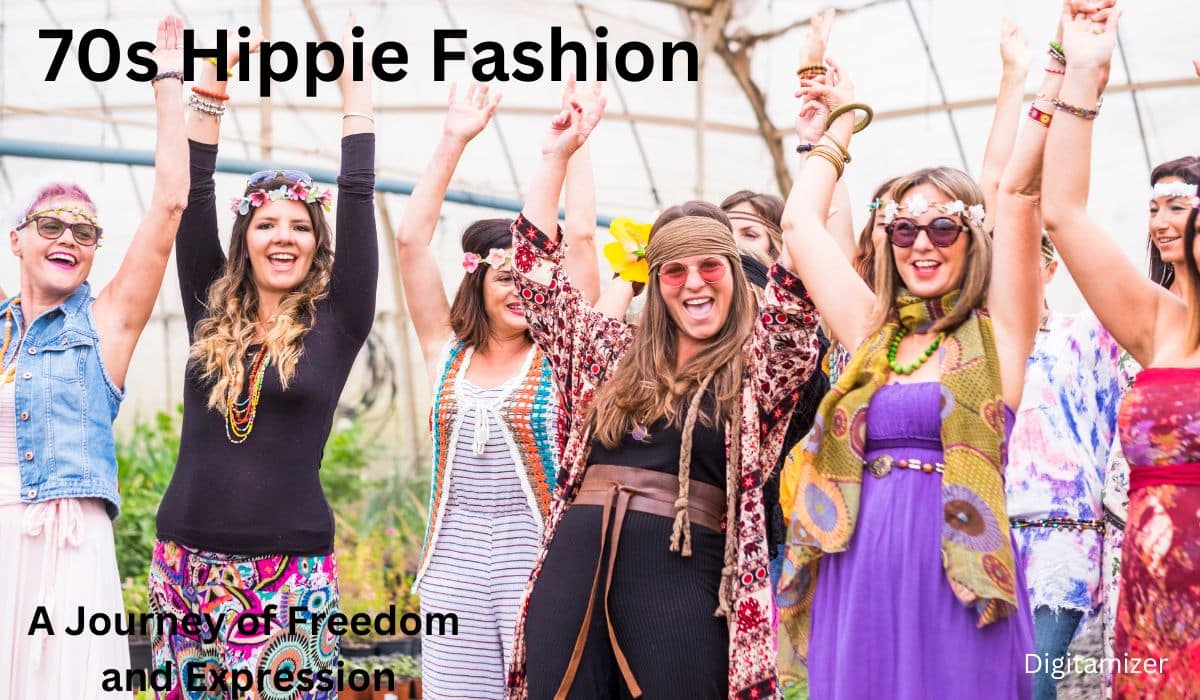Introduction – 70s Hippie Fashion
The Nineteen Seventies stands as a pivotal era in history marked by seismic shifts in social recognition and cultural expression. Central to this transformative length was the emergence and zenith of the hippie movement, whose ethos of peace, love, and freedom permeated each side of society, together with fashion.
The 70s hippie fashion turned into a colorful tapestry of eclectic patterns, shades, and textures, reflecting a rejection of the mainstream way of life and a quest for individuality.
From tie-dye and bell bottoms to fringe and floral prints, the hippie style became synonymous with a countercultural lifestyle that embraced creativity, self-expression, and a rejection of societal norms.
This article delves into the groovy evolution of the 70s hippie style, exploring its origins, key elements, and enduring legacy in shaping contemporary fashion and cultural moves.
As we delve into this colorful journey, we uncover now not just a style announcement but a profound manifestation of the human preference for freedom, team spirit, and authenticity.
70s hippie fashion became a generation marked by profound social change, and nowhere became this extra glaring than inside the realm of favor. The hippie motion, which had its roots in the ’60s, reached its zenith in the 70s, influencing no longer only track, artwork, and politics but also leaving an indelible mark on fashion.
Characterized by a rejection of mainstream tradition and a quest for peace, love, and freedom, the hippie fashion of the 70 hippie fashion changed into a colorful tapestry of eclectic styles, colorations, and textures. This article explores the groovy evolution of the 70s hippie fashion, from tie-dye and bell bottoms to fringe and floral prints.
The Birth of Hippie Fashion – 70s Hippie Fashion
The delivery of hippie fashion can be traced again to the tumultuous social landscape of the Sixties, a decade marked by giant disillusionment with conventional values and establishments.
As the Vietnam War raged on and civil rights protests engulfed the country, a countercultural motion commenced to take form through the reputation quo and advocating for peace, love, and freedom.
At the coronary heart of this movement were the hippies, a diverse group of younger those who rejected the materialism and conformity of mainstream society in choosing an extra communal and spiritually-oriented manner of lifestyle.
Hippie fashion emerged as a visible expression of those beliefs, reflecting a desire to break free from the limitations of conventional apparel norms and embody an extra liberated and individualistic fashion.
Drawing notions from some assets, which include Native American spirituality, Eastern mysticism, and psychedelic art, hippie fashion changed characterized by using its bold colorings, flowing fabrics, and eclectic mix of styles and textures.
One of the defining features of hippie fashion was its rejection of heavily produced clothing in a desire for hand-crafted or thrifted clothes.
Tie-dye became a popular approach for customizing clothing, with each garment serving as a unique canvas for self-expression. Bell bottoms, with their exaggerated flare, became an image of motion, imparting a playful nod to 1960s counterculture while additionally providing a feel of freedom and movement.
As the hippie movement received momentum for the duration of the past due 1960s and into the early 1970s, its impact on style continued to develop. From music galas to college campuses, hippie fashion has become increasingly mainstream, inspiring designers, outlets, and fashionistas around the arena.
While the heyday of the hippie movement may additionally have exceeded, its legacy lives on inside the enduring enchantment of tie-dye, bell-bottoms, and different elements of 70s hippie fashion, serving as a reminder of the energy of favor to reflect and form social trade.
Key Elements of 70s Hippie Fashion
The 1970s hippie fashion was characterized by numerous key elements that epitomized the countercultural motion’s spirit of freedom, self-expression, and rebellion against mainstream norms.
Tie-Dye:
Perhaps the most iconic symbol of hippie style, tie-dye changed into a psychedelic explosion of coloration that decorated everything from T-shirts to attire. The DIY ethos of tie-dye pondered the hippie’s rejection of purchaser tradition, with each garment being a unique expression of creativity and individuality.
Bell-Bottoms:
Bell bottoms featured flared bottoms that have become a staple of the 70s hippie style. Originally worn by sailors in the nineteenth century, they have been embraced via the counterculture motion for their rebellious spirit and laid-returned vibe. Paired with flowy tops and platform footwear, bell bottoms have become an image of freedom and self-expression.
Fringe:
Inspired by the aid of Native American and Western effects, fringe became a popular embellishment in the 70s hippie fashion. Whether redecorating jackets, vests, or luggage, fringe introduced movement and aptitude to clothes, evoking a feeling of adventure and escapism.
Floral Prints:
Hippies embraced floral prints as a symbol of peace, love, and harmony. Whether in the form of maxi dresses, peasant blouses, or headbands, floral prints embodied the loose-lively aesthetic of the technology.
Ethnic Influences:
The hippie style embraced numerous cultures and traditions, reflected in garb inspired using international impacts such as Indian tunics and African textiles. This appreciation for cultural variety promoted harmony and team spirit in a few of the counterculture movements.
The Influence of Music and Art – 70s Hippie Fashion
Music and art performed a profound position in shaping the 70’s hippie style, serving as both a supply of suggestion and a way of expression for the countercultural motion.
The upward thrust of rock tunes, particularly psychedelic rock, furnished a soundtrack for the generation, with bands like The Beatles, Jimi Hendrix, and The Grateful Dead influencing no longer the sound but additionally the fashion of the time.
Their music, regularly characterized by experimental sounds and mind-expanding lyrics, mirrored the psychedelic stories embraced utilizing hippies, inspiring a style aesthetic that changed into similarly formidable and boundary-pushing.
Album covers, in particular, became works of artwork of their right, showcasing vibrant colorations, intricate styles, and surreal imagery that captured the psychedelic spirit of the instances.
Artists like Peter Max and Wes Wilson recognized for their psychedelic posters and album artwork, similarly fueled the visible language of hippie style, with their ambitious colorations and psychedelic styles becoming synonymous with the technology.
Artistic expression extended beyond album covers to stay performances and tune fairs, in which difficult-level costumes and avant-garde style have become a part of the spectacle.
The fusion of music and art within the 70s hippie fashion no longer best encouraged but additionally catalyzed social trade and tough traditional notions of beauty, gender, and identity.
Fashion Icons of the 70s Hippie Fashion
The 1970s produced a plethora of favorite icons who epitomized the loose-spirited and eclectic style of the era. Musicians, actors, and cultural influencers alike embraced the hippie aesthetic, setting trends and galvanizing limitless imitators.
Janis Joplin, with her bohemian aptitude and ambitious feel of self-expression, became an icon of 70s hippie fashion. Her eclectic wardrobe of flowing attire, fringe jackets, and layered jewelry captured the spirit of the counterculture movement, earning her a place in style records.
Jimi Hendrix, along with his vivid degree presence and avant-garde fashion, also left an indelible mark on 70s fashion. His formidable use of coloration, pattern, and texture pushed the bounds of conventional menswear, inspiring a generation of musicians and fashionistas to include individuality and self-expression.
Actresses like Jane Fonda and Cher also performed a big position in shaping 70s fashion, with their bold crimson carpet looks and iconic on-display personas.
From Fonda’s shape-becoming jumpsuits to Cher’s daring sequined ensembles, these ladies embodied the fearless spirit of the generation, tough traditional notions of femininity and splendor.
Together, those fashion icons helped define the look of the 1970s, inspiring a generation to embrace self-expression, individuality, and freedom of their clothing alternatives. Their legacy keeps steering designers and fashionistas to the moment, serving as a reminder of the iconic strength of favor to reflect and shape cultural identity.
Legacy and Impact – 70s Hippie Fashion
The legacy of the 70s hippie style extends a long way past the last decade itself, leaving an indelible mark on each fashion and subculture. While the heyday of the hippie motion may additionally have exceeded, its impact keeps reverberating through modern-day fashion tendencies and cultural moves.
Elements of 70s hippie fashion, including tie-dye, bell-bottoms, and fringe, have skilled periodic resurgences in mainstream fashion, demonstrating the enduring appeal of the counterculture aesthetic.
From the bohemian sublime of track festivals like Coachella to the runway collections of excessive-end designers, hippie-stimulated seems to continue to captivate audiences and encourage new generations of favor fanatics.
Moreover, the ethos of peace, love, and freedom that defined the hippie motion remains relevant in the state-of-the-art world, serving as a rallying cry for social justice, environmental activism, and character empowerment.
The values of inclusivity, variety, and sustainability are championed by using hippie preserves to tell modern-day conversations approximately identity, community, and the destiny of our planet.
In this way, the legacy of the 70s hippie fashion transcends mere fashion developments, serving as a timeless reminder of the strength of flavor to mirror and form cultural values.
As we navigate the complexities of the current age, we may also draw ideas from the groovy evolution of the 70s hippie style, embracing its spirit of creativity, self-expression, and collective liberation.
Conclusion – 70s Hippie Fashion
In conclusion, the groovy evolution of 70s hippie fashion stands as a colorful testament to the power of fashion to mirror and shape cultural values. Emerging from the tumultuous social landscape of the 1960s, the hippie style represented a rejection of mainstream norms and a quest for individuality, freedom, and self-expression.
Through key elements together with tie-dye, bell bottoms, fringe, floral prints, and ethnic effects, hippies crafted a visual language that embodied their ideals of peace, love, and team spirit.
While the heyday of the hippie motion may additionally have exceeded, its legacy lives on in modern-style tendencies, cultural actions, and social activism.
Elements of the 70s hippie fashion encourage designers, musicians, and artists around the world, serving as a reminder of the long-lasting energy of creativity, authenticity, and collective liberation.
As we reflect on the colorful journey of 70s hippie fashion, we may also be inspired to embrace its spirit of individuality, inclusivity, and environmental stewardship in our personal lives.
In a global regularly fraught with division and uncertainty, we can also discover solace and thought in the undying message of peace, love, and freedom embodied by hippie style, forever echoing through the corridors of time. Peace, love, and style for all time.
What had been the main style trends of the 1970s hippie motion?
The essential style traits of the Nineteen Seventies hippie motion protected tie-dye, bell-bottoms, fringe, floral prints, ethnic influences, and a DIY ethos.
Where did the hippie style draw the notion from?
Hippie fashion drew suggestions from a whole lot of sources, which include Native American spirituality, Eastern mysticism, psychedelic art, and global cultures.
Who were a number of the style icons of the 70s hippie movement?
Fashion icons of the 70s hippie movement blanketed musicians like Janis Joplin and Jimi Hendrix, in addition to actresses like Jane Fonda and Cher.
How did track and art affect the 70s hippie style?
Music and artwork played a profound role in shaping the 70s hippie style, serving as both a source of proposal and a method of expression for countercultural motion.
What is the legacy of the 70s hippie style?
The legacy of 70s hippie fashion continues to persuade modern style trends, cultural actions, and social activism, embodying values of individuality, inclusivity, and environmental stewardship.
Digital Marketing Services, SEO and E-Commerce Solutions in Delhi, India
Author – Farhanul Haque
The article “70s Hippie Fashion: A Colorful Journey of Freedom and Expression” is written by the Founder of Digitamizer who has been working in the e-commerce Sector Since 2006 and is also a certified Digital Marketing Professional from IIT, Delhi, India.




